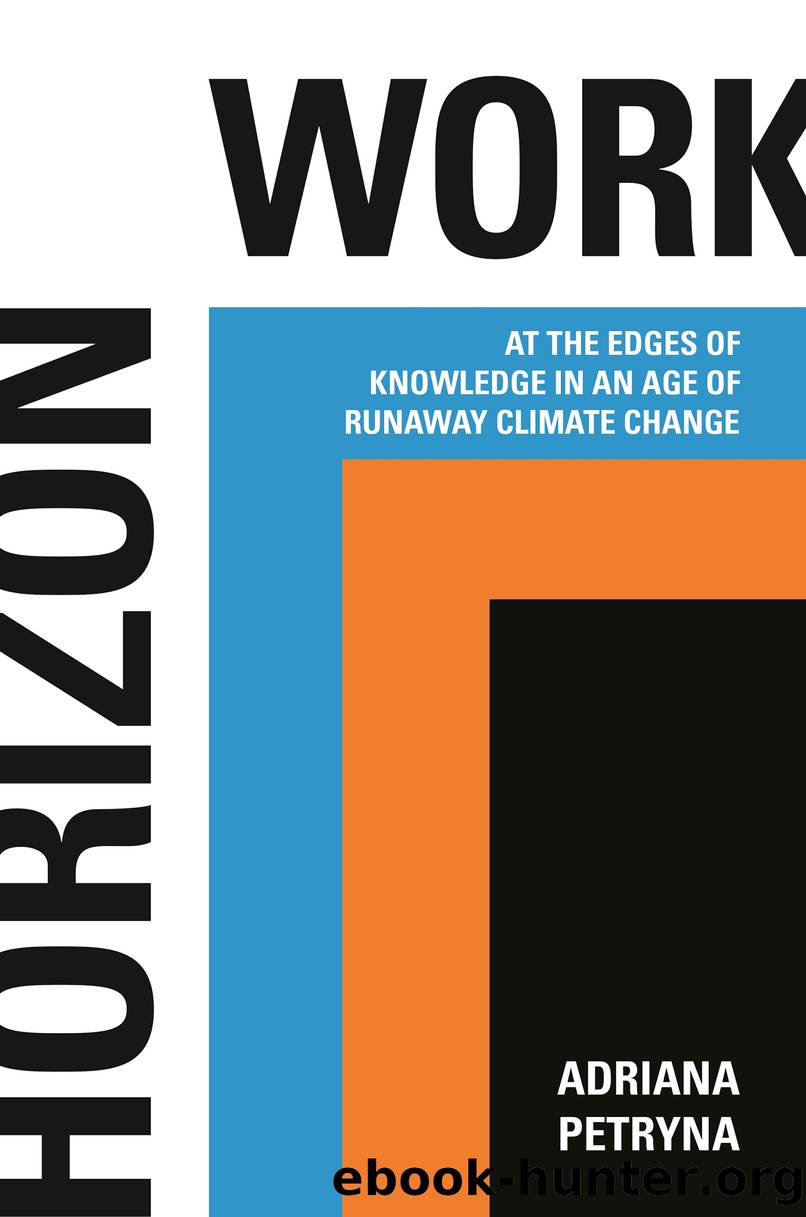Horizon Work by Adriana Petryna;

Author:Adriana Petryna;
Language: eng
Format: epub
Publisher: Princeton University Press
Published: 2021-11-24T00:00:00+00:00
Little Green Pine Needles
In the meantime, what can a commitment to scientific inquiry amid âmonumentalâ cognitive dissonance look like? Earlier I mentioned that the strong personalities that set the direction of wildfire science in the United States were steeped in, and at times clung dogmatically to, mathematical deductionâeven when outcomes of that deduction could be inconsistent with physical reality. The inconsistency was tolerated, even for something as basic and consequential as the mechanism of wildfire spread.
To see this mechanism, imagine a big, flat wall: when enough energy is transferred to it, it will ignite. The heat transfer mechanism in this instance is called radiation, in which ignition occurs without direct contact with flames (the air transfers heat from flames or burning objects to adjacent fuels). In structural fire protection, radiation explains the combustibility of objects (like big flat walls or furniture) that are compact or solid and have continuous surfaces. But wildfire typically spreads in discontinuous and variable surfacesâin fine or loosely packed vegetation, such as pine needles, leaves, twigs, grasses, and bark. Though radiation was an assumed heat transfer mechanism here, it was never sufficiently validated. And if radiation doesnât always explain how wildfire spreads, then what does?
Early on in his career, Cohen (and later Finney and other colleagues) saw that physically meaningful descriptions of wildland fire heat transferâand the experimental studies from which those descriptions could be derivedâwere missing. Conventional fire-spread modeling assumed a governing heat transfer mechanism that also governed the kinds of questions that these researchers could ask. Alternatives, like convection, a form of heat transfer in liquids and gases, had been explored, but not enough. When Cohen raised the possibility of convection with a dominant wildland fire modeler at the lab in 1981, the modeler shut it down right away, saying that convection canât be responsible for wildfire spread and, âif that was true, itâd all burn to a shockwave!â
By that time, however, Cohen had already left the Missoula Fire Lab and moved to Southern California, where he worked at the US Forest Serviceâs Riverside Fire Lab. Committing himself to studying phenomena that had become âphysically inconsistent with perception,â he first focused on so-called live fuels (or living vegetation). Live fuels were of particular interest because they donât burn the same way dead fuels do. He knew he had to do a lot of observing to be able to come up with effective questions about their ignition properties. So he farmed himself out as a fire-behavior analyst to local districts so that he could run prescribed burns. He took on a job as a lightning supervisor for the San Bernardino National Forest, and he studied fuel breaksâbarriers to wildfire spread made of damaged soils or bulldozed ruts where nothing supposedly burns, including live fuels.
He focused on chamise chaparral, a common shrub, which grows in those fuel breaks. When he set a bit of it alight, he watched the supposedly inconsequential little shrubs burn. Fire-spread models skipped over the fact that the needle-like bundles that sprout from them âwill carry fire all by themselves quite nicely.
Download
This site does not store any files on its server. We only index and link to content provided by other sites. Please contact the content providers to delete copyright contents if any and email us, we'll remove relevant links or contents immediately.
Man-made Catastrophes and Risk Information Concealment by Dmitry Chernov & Didier Sornette(5647)
The Revenge of Geography: What the Map Tells Us About Coming Conflicts and the Battle Against Fate by Kaplan Robert D(3961)
Zero Waste Home by Bea Johnson(3655)
In a Sunburned Country by Bill Bryson(3366)
COSMOS by Carl Sagan(3346)
Good by S. Walden(3346)
The Fate of Rome: Climate, Disease, and the End of an Empire (The Princeton History of the Ancient World) by Kyle Harper(2870)
Camino Island by John Grisham(2719)
A Wilder Time by William E. Glassley(2690)
Organic Mushroom Farming and Mycoremediation by Tradd Cotter(2565)
The Ogre by Doug Scott(2501)
Human Dynamics Research in Smart and Connected Communities by Shih-Lung Shaw & Daniel Sui(2431)
Energy Myths and Realities by Vaclav Smil(2380)
The Traveler's Gift by Andy Andrews(2299)
9781803241661-PYTHON FOR ARCGIS PRO by Unknown(2268)
Inside the Middle East by Avi Melamed(2230)
Birds of New Guinea by Pratt Thane K.; Beehler Bruce M.; Anderton John C(2175)
A History of Warfare by John Keegan(2104)
Ultimate Navigation Manual by Lyle Brotherton(2048)
